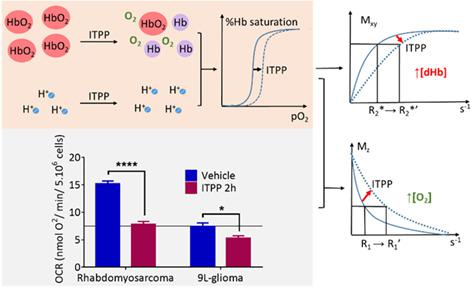当前位置:
X-MOL 学术
›
NMR Biomed.
›
论文详情
Our official English website, www.x-mol.net, welcomes your feedback! (Note: you will need to create a separate account there.)
Combined endogenous MR biomarkers to assess changes in tumor oxygenation induced by an allosteric effector of hemoglobin.
NMR in Biomedicine ( IF 2.9 ) Pub Date : 2019-11-25 , DOI: 10.1002/nbm.4181 Thanh-Trang Cao-Pham 1 , An Tran-Ly-Binh 1 , Arne Heyerick 2 , Catherine Fillée 3 , Nicolas Joudiou 1 , Bernard Gallez 1 , Bénédicte F Jordan 1
NMR in Biomedicine ( IF 2.9 ) Pub Date : 2019-11-25 , DOI: 10.1002/nbm.4181 Thanh-Trang Cao-Pham 1 , An Tran-Ly-Binh 1 , Arne Heyerick 2 , Catherine Fillée 3 , Nicolas Joudiou 1 , Bernard Gallez 1 , Bénédicte F Jordan 1
Affiliation

|
Hypoxia is a crucial factor in cancer therapy, determining prognosis and the effectiveness of treatment. Although efforts are being made to develop methods for assessing tumor hypoxia, no markers of hypoxia are currently used in routine clinical practice. Recently, we showed that the combined endogenous MR biomarkers, R1 and R2 *, which are sensitive to [dissolved O2 ] and [dHb], respectively, were able to detect changes in tumor oxygenation induced by a hyperoxic breathing challenge. In this study, we further validated the ability of the combined MR biomarkers to assess the change in tumor oxygenation induced by an allosteric effector of hemoglobin, myo-inositol trispyrophosphate (ITPP), on rat tumor models. ITPP induced an increase in tumor pO2 , as observed using L-band electron paramagnetic resonance oximetry, as well as an increase in both R1 and R2 * MR parameters. The increase in R1 indicated an increase in [O2 ], whereas the increase in R2 * resulted from an increase in O2 release from blood, inducing an increase in [dHb]. The impact of ITPP was then evaluated on factors that can influence tumor oxygenation, including tumor perfusion, saturation rate of hemoglobin, blood pH and oxygen consumption rate (OCR). ITPP decreased blood [HbO2 ] and significantly increased blood acidity, which is also a factor that right-shifts the oxygen dissociation curve. No change in tumor perfusion was observed after ITPP treatment. Interestingly, ITPP decreased OCR in both tumor cell lines. In conclusion, ITPP increased tumor pO2 via a combined mechanism involving a decrease in OCR and an allosteric effect on hemoglobin that was further enhanced by a decrease in blood pH. MR biomarkers could assess the change in tumor oxygenation induced by ITPP. At the intra-tumoral level, a majority of tumor voxels were responsive to ITPP treatment in both of the models studied.
中文翻译:

结合内源性MR生物标记物来评估血红蛋白的变构效应物诱导的肿瘤氧合作用的变化。
缺氧是癌症治疗,决定预后和治疗效果的关键因素。尽管正在努力开发评估肿瘤缺氧的方法,但是常规临床实践中目前没有使用缺氧标记物。最近,我们表明,结合的内源性MR生物标记物R1和R2 *分别对[溶解的O2]和[dHb]敏感,能够检测高氧呼吸激发引起的肿瘤氧合作用的变化。在这项研究中,我们进一步验证了组合的MR生物标记物在大鼠肿瘤模型上评估血红蛋白的变构效应物肌醇三焦磷酸酯(ITPP)诱导的肿瘤氧合变化的能力。使用L带电子顺磁共振血氧饱和度法观察到,ITPP诱导了肿瘤pO2的增加,以及R1和R2 * MR参数的增加。R1的增加表示[O2]的增加,而R2 *的增加是由于血液中O2的释放增加,导致[dHb]的增加。然后评估ITPP对可能影响肿瘤氧合的因素的影响,包括肿瘤灌注,血红蛋白饱和度,血液pH值和耗氧率(OCR)。ITPP降低了血液[HbO2]并显着增加了血液酸度,这也是使氧解离曲线右移的一个因素。ITPP治疗后未观察到肿瘤灌注的变化。有趣的是,ITPP降低了两种肿瘤细胞系的OCR。综上所述,ITPP通过包括OCR降低和对血红蛋白的变构作用的联合机制增加了肿瘤pO2,而血液pH的降低则进一步增强了它的变构作用。MR生物标志物可以评估ITPP诱导的肿瘤氧合作用的变化。在肿瘤内水平上,在两个研究模型中,大多数肿瘤体素均对ITPP治疗有反应。
更新日期:2020-01-21
中文翻译:

结合内源性MR生物标记物来评估血红蛋白的变构效应物诱导的肿瘤氧合作用的变化。
缺氧是癌症治疗,决定预后和治疗效果的关键因素。尽管正在努力开发评估肿瘤缺氧的方法,但是常规临床实践中目前没有使用缺氧标记物。最近,我们表明,结合的内源性MR生物标记物R1和R2 *分别对[溶解的O2]和[dHb]敏感,能够检测高氧呼吸激发引起的肿瘤氧合作用的变化。在这项研究中,我们进一步验证了组合的MR生物标记物在大鼠肿瘤模型上评估血红蛋白的变构效应物肌醇三焦磷酸酯(ITPP)诱导的肿瘤氧合变化的能力。使用L带电子顺磁共振血氧饱和度法观察到,ITPP诱导了肿瘤pO2的增加,以及R1和R2 * MR参数的增加。R1的增加表示[O2]的增加,而R2 *的增加是由于血液中O2的释放增加,导致[dHb]的增加。然后评估ITPP对可能影响肿瘤氧合的因素的影响,包括肿瘤灌注,血红蛋白饱和度,血液pH值和耗氧率(OCR)。ITPP降低了血液[HbO2]并显着增加了血液酸度,这也是使氧解离曲线右移的一个因素。ITPP治疗后未观察到肿瘤灌注的变化。有趣的是,ITPP降低了两种肿瘤细胞系的OCR。综上所述,ITPP通过包括OCR降低和对血红蛋白的变构作用的联合机制增加了肿瘤pO2,而血液pH的降低则进一步增强了它的变构作用。MR生物标志物可以评估ITPP诱导的肿瘤氧合作用的变化。在肿瘤内水平上,在两个研究模型中,大多数肿瘤体素均对ITPP治疗有反应。



























 京公网安备 11010802027423号
京公网安备 11010802027423号